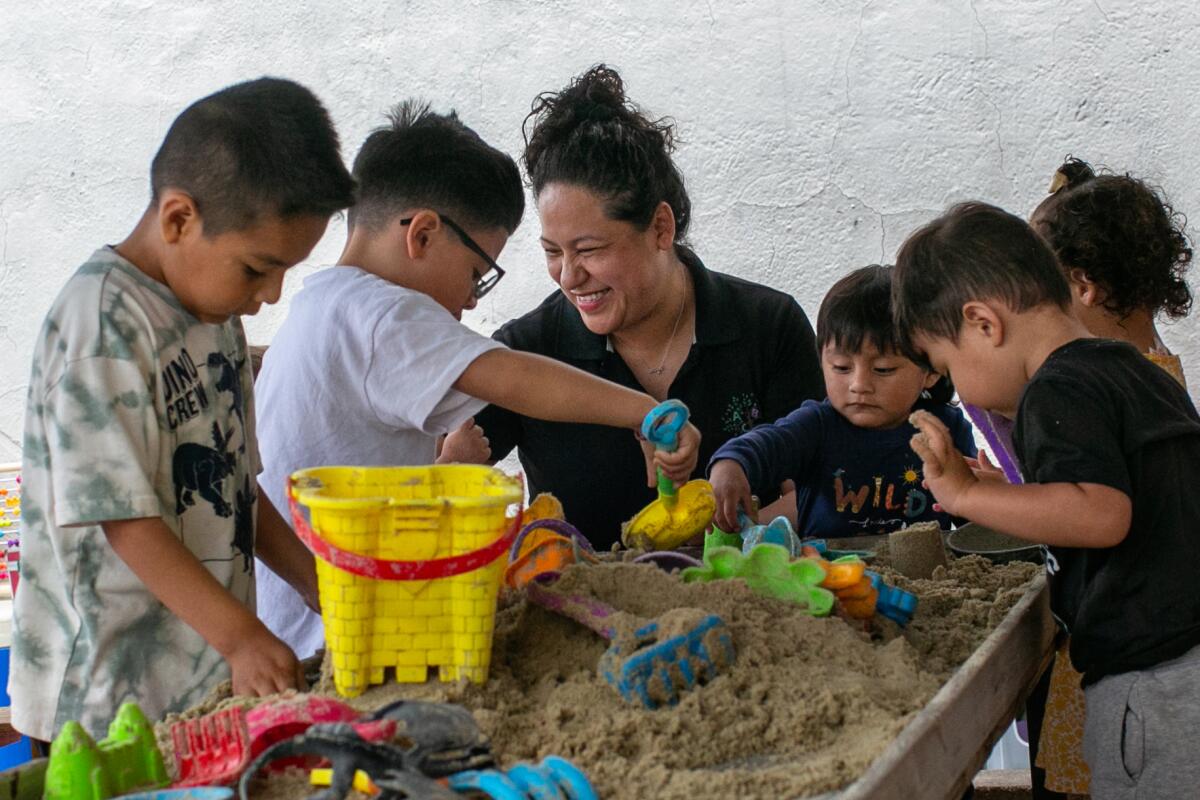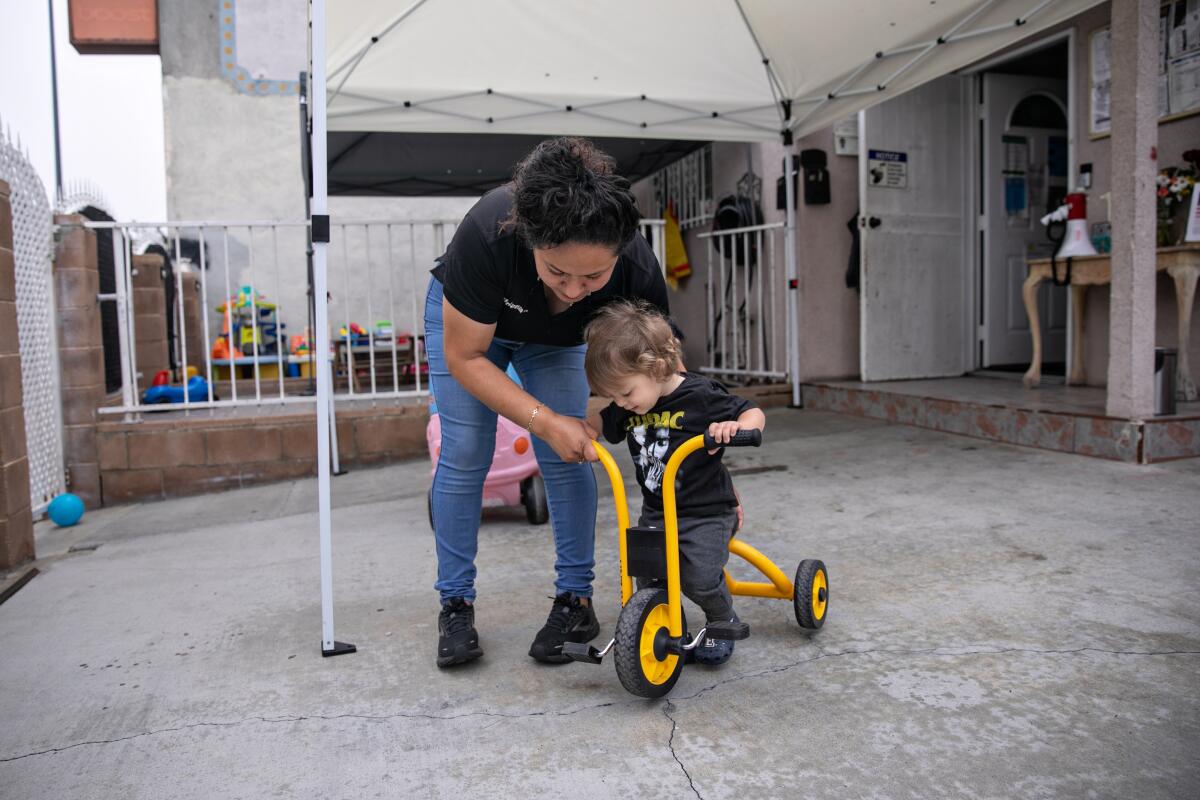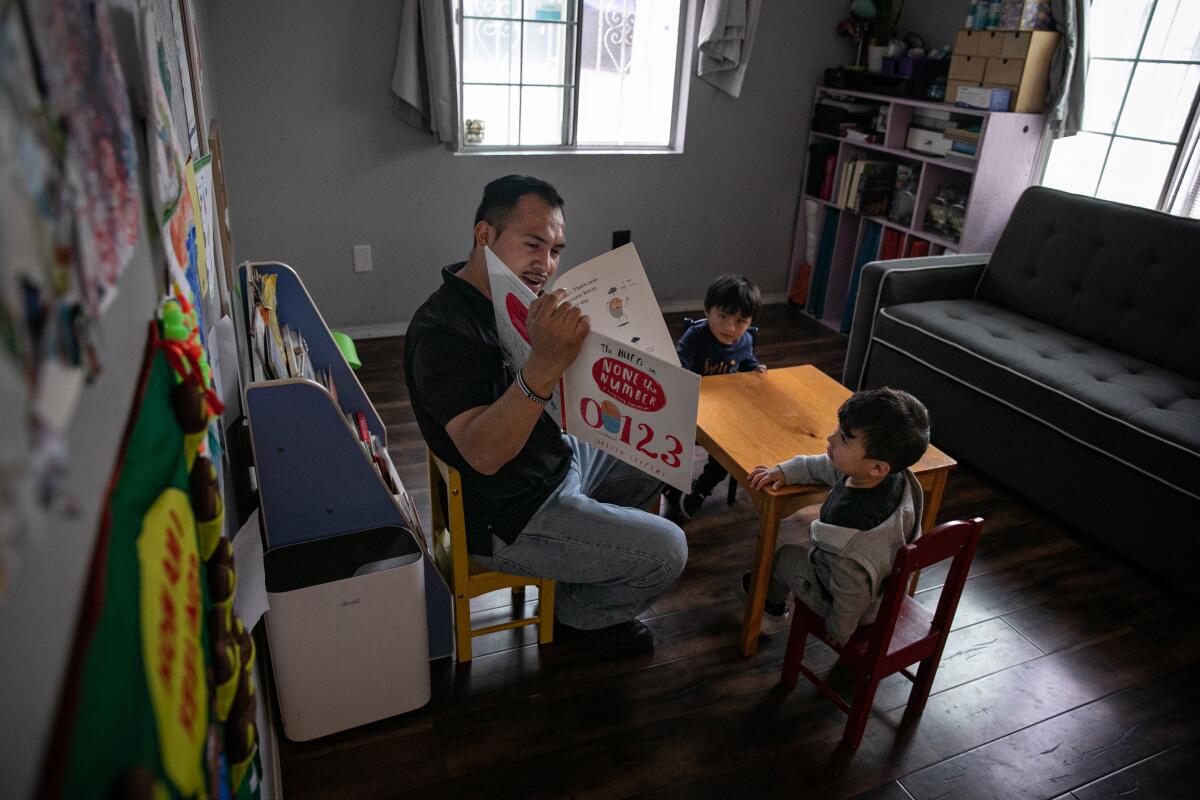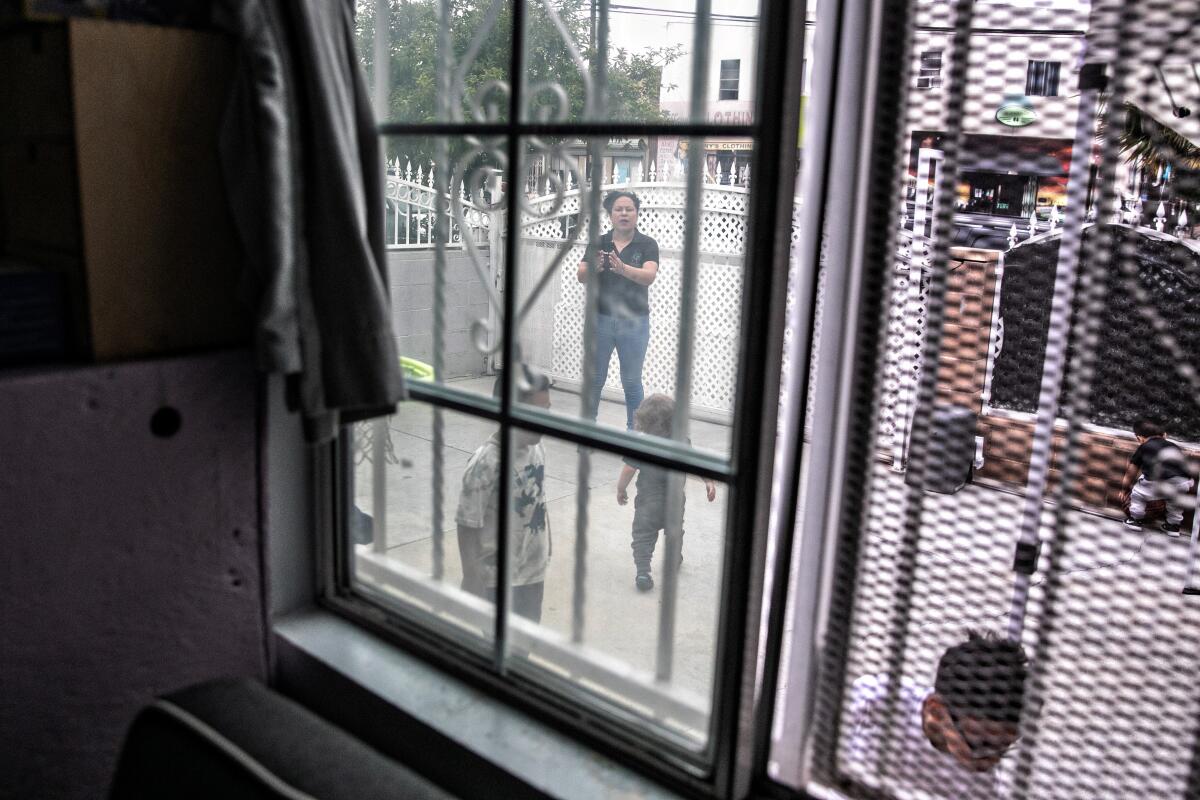Child-care providers by day, Amazon drivers by night. Workers fight for living wages

Behind the white iron gate of her Boyle Heights home, Adriana Lorenzo’s concrete courtyard is filled with half a dozen tricycles, a basketball hoop and the melodic cadences of classical music that resonate through the play area. “It keeps the kids happy and calm,” she says.
Lorenzo owns her own child-care program, taking care of 14 children. On a recent Wednesday, she holds baby Elijah, 13 months, close to her chest, swaying back and forth as she brushes the hair from his eyes. Lorenzo has been working since 5 a.m., when she got up to sanitize the bathrooms and cook pancakes and eggs for the children before they began arriving at 6:30 a.m. Her last charge won’t head home until after 5:30 p.m.
She works 13 hours a day, five days a week, wiping tears, kissing owies, teaching the ABCs, and bending over to pick up countless toys. Nearly all her children come from low-income families and qualify for state vouchers that pay for the care. The rate varies by the age of a child, but for a 2-year-old, California pays Lorenzo up to $1,006 per month. After covering all her business expenses, including electricity, supplies, rent, food and the salary of a full-time aide, she says her childcare operation brings in about $1,000 per month.

So at midnight several times a week, she and her husband, who helps with the business, head out in their truck for a second shift: delivering food and packages for Amazon Flex.
California’s voucher rates are at the heart of a battle brewing over how much the state pays home child-care providers like Lorenzo, who run day care programs out of their homes. Such programs are licensed by the state and operators can care for up to 14 children at a time, sometimes some as young as 2 weeks old. Often, they are the only care option for parents working nontraditional hours — the farmworkers who start before dawn, janitors on the graveyard shift, the warehouse workers stocking shelves overnight. Most in-home child-care providers are women of color, many of them immigrants.
On Thursday, Lorenzo will travel to Sacramento to lobby legislators to raise the amount the state pays for the more than 290,000 child-care vouchers offered to low-income families, and to overhaul the way those rates are set. It’s the latest fight in a two-decade crusade by child-care workers in California over pay and benefits.

In 2019, Gov. Gavin Newsom signed legislation to allow child-care workers who provide care in home settings to join a union and negotiate directly with the state over their fees. The Child Care Providers United, or CCPU, which represents 40,000 home child-care providers in California, negotiated its first contract with the state in 2021. That contract expires at the end of June.
About a third of home child-care programs accept state vouchers. The annual median income for providers running small programs serving up to eight children ranged from $19,600 to $30,200, depending on various factors, including the number and ages of children served. For those running larger programs serving up to 14 children, the median ranged from $46,200 to $57,500, according to a 2020 study from the Center for the Study of Child Care Employment at UC Berkeley (CSCCE).
It’s difficult to calculate an hourly wage, since many home child-care providers work more than eight hours per day, but Child Care Providers United reports that many earn less than minimum wage. Vouchers can also be used to pay for care provided at larger child-care centers or by family friends and neighbors.
The union has been in negotiations since January, requesting higher wages, paid time off and health and retirement benefits. But negotiators say the state appears to be stalling. “We hear about the governor investing in child-care providers, but then we hear what he’s offering, the words don’t match the actions,” says Max Arias, the union’s chief negotiator. “I don’t think they’re acting in bad faith, but the governor is either disconnected from what’s happening at the table or there’s a lack of urgency.”
Max Arias fell into union organizing by accident, finding that his greatest satisfaction came not in raising his own voice but helping others find theirs.
“I don’t think our members have given up on the idea that one day they might strike. Just because it hasn’t happened yet doesn’t mean it won’t,” Arias added.

The Legislature has gotten involved as well, with the Assembly proposing a 25.44% rate increase in the 2023-24 budget to account for inflation. The Senate is proposing a similar figure, about $1 billion more in annual state funding.
In contrast, the governor did not include any rate increase for most in-home child-care workers in his May budget proposals.
Here’s what you need to know about Gov. Gavin Newsom’s plan to offset California’s $31.5-billion budget deficit.
“It’s now a crisis, and if we don’t fix it, there are providers that are going to be closing their doors, and the system could very well fall apart,” says Assembly Majority Leader Eloise Gómez Reyes (D-Colton), who is pushing for the 25.44% funding increase. “I would like [the governor] to watch the tapes from when he was first elected. He was committed to this.”
In response to written questions, H.D. Palmer, a spokesperson for the state Department of Finance, said deliberations with the union were underway. He declined to comment on specific wage questions while negotiations are ongoing.
But any increase to the state voucher amount is a Band-Aid until the state overhauls the entire way child-care subsidies are set, says Anna Powell, who researches California’s early care and education system at the Center for the Study of Child Care Employment. Currently, the rates paid to child-care providers are based on a market survey of the regional prices in 2016.
“Wages flow directly from what parents can afford to pay,” Powell said.
As California expands access to transitional kindergarten for all 4-year-olds, districts across the state struggle to recruit and accommodate young learners.
The problem, at its heart, is that child care costs far more to provide than most parents can afford. The result is a “market failure” in which state vouchers pay only a fraction of what it costs to provide high-quality child care, according to a report from California’s Rate and Quality Workgroup, which seeks to establish a new reimbursement rate structure.
To create an equitable payment plan, the group wrote, “California must first acknowledge the systemic racism, classism, sexism, and stereotypical beliefs embedded in current child care funding and policies.”
Current state rates often fall short. In the Los Angeles region, for example, providing full-time care to a preschooler costs $2,240 monthly, yet the voucher covers $1,253, according to a recent brief from the Child Care Resource Center, a nonprofit that helps connect families in northern Los Angeles County and San Bernardino County with child care and subsidies. In the San Bernardino area, full-time preschooler care costs $2,078 and the voucher covers $881.
More than 1,100 organizations, including the Service Employees International Union and the state Chamber of Commerce, have signed a letter urging the governor to commit to a 25% rate increase this year and an overhaul of the rate-setting system to tie payments to what it actually costs to provide the care.

Both the Assembly and Senate are advancing legislation to commit the state to long-term rate reform. New Mexico, Washington, D.C., and Virginia have already implemented alternative structures. Several other states, including Washington state, Oregon and Delaware, are in the process of similar overhauls.
In the meantime, many owners of small home child-care centers say they are barely scraping by.
Some have already closed their doors, exacerbating an existing shortage of options for families who need it. About 12% of licensed child care capacity in California closed permanently during the pandemic, according to data from the Department of Social Services cited in a recent Assembly hearing.
Lorenzo and her husband turned to their Amazon routine during the pandemic, “just to keep the business running,” she said. They had quickly spent their small savings as the price for milk, baby wipes and cleaning supplies grew ever higher.
“We did think about closing. I even talked to the parents about it,” she said. “But I had two kids who cried for us not to close. That made us change our minds.”
Zoila Carolina Toma, who runs an in-home program in Lakewood, says providers know they’re underpaid, but “it’s hard to get out of the business when you’re in. You need a Plan B.” She juggles several groups of children to make the business work, including older kids whom she picks up and drops off at school. She’s made repeated trips to Sacramento to lobby the state for additional funds since starting her program in 2011, but with little success.
“The state says children are a priority, but in reality I don’t see it,” Toma says.
Low-income families sometimes struggle to find a child-care provider willing to accept their voucher.
Itzel Gonzalez, 29, a mother of three from San Diego, was told by her child-care provider that she could no longer afford to accept the low voucher rates. Gonzalez said a case worker gave her phone numbers for a few others, but they were no longer in service. Finally, a friend from church connected her with a provider who had space, but she has to pack some of her children’s food — the voucher just wasn’t enough to cover nutritional needs.
In Contra Costa County, Leshay Burks, 34, has been on the waiting list at a child-care center for two years. In the meantime, her mother watches her two children, which often means loading them into the backseat while she works driving for DoorDash.
Burks says she worries about sending her children to a day-care provider who isn’t being paid a living wage.
“You expect us to give this little voucher to someone and then give them our kids? This is all we have. They’re our everything. You want us to give them to someone who is financially stressed and then say, ‘Bye, have a good day,’ and expect them to give loving care?”
Providers report that they are also inundated with requests from families.
Deborah Corley-Marzett has been running a family day care program out of her home in Bakersfield for the last 20 years. Every week, she said, she receives calls from families desperate to find care. She’s full, so she tries to refer them to other providers in her area, but spots are difficult to come by, especially for babies and toddlers, who require more attention and resources.
Most of them can’t go to the larger day-care centers or state preschools that offer traditional hours of care. The families she serves often work night shifts at Walmart, convalescent homes or an Amazon warehouse. “These are the people who keep our cities going at night,” she explains.
Families knock on her door at all hours to drop off their children — 10 p.m., 1a.m., 3:30 a.m., 5:30 a.m. She greets the children, puts them to bed and then wakes them up in the morning for school. She tries to catch some sleep in between, but at the age of 59, she is starting to get tired.
“I am grateful for this extremely busy life. I really am. I love what I do,” she says. “But I can’t provide a service just on love or a few dollars. It needs to change for providers.”
Watch L.A. Times Today at 7 p.m. on Spectrum News 1 on Channel 1 or live stream on the Spectrum News App. Palos Verdes Peninsula and Orange County viewers can watch on Cox Systems on channel 99.
More to Read
Sign up for Essential California
The most important California stories and recommendations in your inbox every morning.
You may occasionally receive promotional content from the Los Angeles Times.















